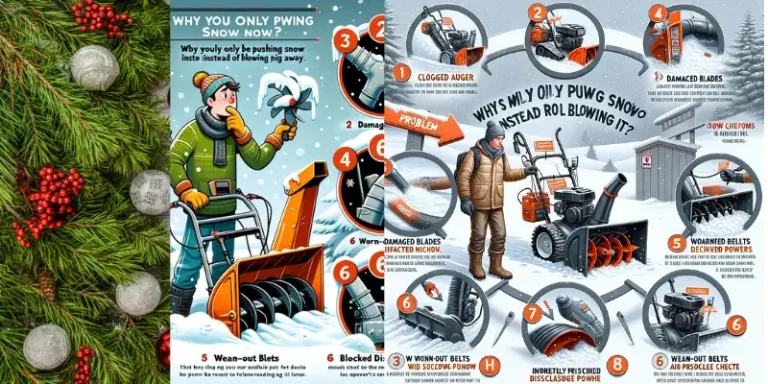Can a Snow Blower Remove Leaves? Understanding the Potential of Snow Blowers Beyond Snow Removal
As the seasons transition and the vibrant hues of autumn leaves blanket the ground, homeowners often seek efficient ways to clear their yards. In this quest, the idea of repurposing a snow blower for leaf removal arises. Snow blowers, designed primarily for snow removal, spark curiosity about their versatility and effectiveness in managing fallen leaves. Exploring this intersection between seasonal tools becomes essential in maximizing their utility.
Understanding the adaptability of snow blowers for tasks beyond their conventional purpose requires insight into the mechanics and capabilities of different types. The single-stage, two-stage, and three-stage snow blowers each possess unique features that influence their efficiency in handling leaves. Its depend upon various factors, let’s start assessing:
Single Stage Snow Blower:
A single-stage snow blower, known for its lightweight design and maneuverability, emerges as a plausible option for leaf clearing endeavors. Operating with a high-speed auger to gather snow and expel it through a chute, this type might seem adaptable for handling leaves as well. However, the nuances of its functionality come into play when confronted with varied leaf densities and surface terrains.
While the agility of the single-stage blower renders it suitable for lighter leaf layers on flat surfaces, challenges arise with denser accumulations or uneven ground. The effectiveness of this blower in leaf removal tasks hinges on factors such as the depth of leaves and potential obstacles within them. The auger, optimized for snow, might encounter impediments with leaves, leading to clogging or reduced efficiency.
Additionally, adjusting the height settings meant for snow depths might not seamlessly align with the task of leaf clearance, potentially affecting the overall performance of the machine.
Two-Stage Snow Blower: Evaluating Power Versus Precision in Leaf Management
In contrast to its single-stage counterpart, the two-stage snow blower boasts an auger and an impeller, enhancing its power and snow removal capacity. However, this robust design might not necessarily translate seamlessly into efficient leaf clearance due to its specialized snow-centric features.
The auger-impeller combination that excels in managing snow could face limitations when dealing with leaf piles. The mechanism, optimized for snow’s consistency, might encounter challenges with leaves, leading to potential clogging or less effective removal. The power-packed nature of the two-stage blower might inadvertently pull in more than just leaves, risking the intake of grass or debris along with the foliage. Consequently, while this blower type possesses commendable snow removal capabilities, its application in leaf clearing may be hindered by its specialized design.
Three-Stage Snow Blower: Harnessing Power and Overcoming Challenges in Leaf Removal
The three-stage snow blower, equipped with an accelerator, auger, and impeller, stands as a powerhouse for snow removal tasks. However, its high-powered nature might pose challenges when solely repurposed for leaf clearing, owing to its intensive suction capabilities.
The amalgamation of three stages amplifies the blower’s capacity to tackle heavy snowfalls efficiently. Yet, this robustness might prove excessive for dealing with leaves, especially dry, lighter piles. The powerful suction inherent in this blower might uproot grass or pull in unintended debris alongside the leaves, potentially causing inadvertent damage or inefficiency in the task.
How to Use a Snow Blower on Leaves: Optimizing Performance and Technique
These steps are essential and help you in removing leaves using snow blower.
Adjust Blower Height
Start by adjusting the height settings of the snow blower. Set it to a level that allows the blower to skim over the leaves without digging into the ground. This adjustment ensures efficient leaf removal while preventing damage to the blower or the underlying surface.
Prepare the Area
Prior to using the snow blower, prep the area by mowing the lawn. Mowing helps break down the leaves into smaller, more manageable pieces. This step facilitates smoother leaf removal and reduces the chances of clogging within the blower mechanism.
Clear Obstacles
Before you begin, clear the area of any visible obstacles like rocks, sticks, or debris that might be mixed in with the leaves. Removing these obstructions helps prevent damage to the blower and ensures a smoother operation.
Start Blowing in Rows
Begin using the snow blower in rows, working systematically across the area. Move in a consistent pattern, overlapping each row slightly to ensure thorough coverage and efficient leaf removal.
Adjust Speed and Direction
Control the speed and direction of the blower according to the leaf density and surface terrain. Slower speeds might be necessary for denser leaf piles, while faster speeds could work better for lighter accumulations.
Be Mindful of Wind Direction
Pay attention to the wind direction if it’s windy. Position yourself and the blower so that the wind aids in blowing the leaves away from areas you don’t want them to accumulate.
Regular Maintenance
Throughout the process, periodically check the blower for any signs of clogging. Clear out any debris that might obstruct the chute or auger to maintain optimal performance.
Final Pass and Cleanup
Once you’ve covered the entire area, make a final pass to ensure you haven’t missed any spots. Clean up any remaining leaf piles manually if needed to achieve a thoroughly cleared yard.
By following these steps and employing these techniques, you can maximize the efficiency of your snow blower for leaf removal while minimizing potential issues like clogging and surface damage.
Limitations of Using a Snow Blower on Leaves: Understanding Challenges and Considering Alternatives
While a snow blower can certainly assist in leaf removal, acknowledging its limitations becomes important These machines operate optimally on dry, loosely packed leaves but struggle with wet, dense piles, leading to reduced efficiency or potential damage. Moreover, the presence of sticks or rocks within the leaves poses risks to the blower’s components, necessitating caution during operation.
FINAL THOUGHTS
The use of a snow blower for leaf clearing tasks necessitates a comprehensive understanding of its functionalities, limitations, and the specific conditions at hand. While these machines can aid in certain scenarios, alternative methods or techniques might prove more effective for dense or wet leaf piles. Optimizing their performance requires careful consideration of factors like leaf density, terrain, and machine capabilities to achieve optimal results without compromising efficiency or causing damage.

About Naveed A Hashmi
In my childhood, I used to see my parents while working in the land, for these reasons today I have been serving the same as our own tradition and culture. I thus love to stay in it, because I want to learn something advanced and new so that I may improve my farm’s contour and help others with my experience.







